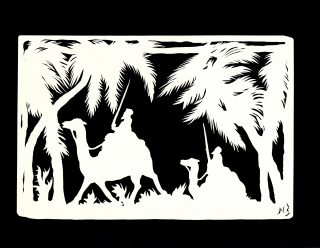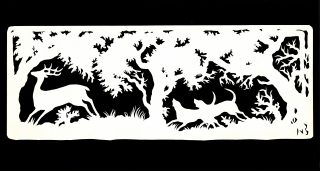The Special Collections department in Mullins Library has materials from remarkable Arkansan artists of all stripes: performers like gifted pioneering African American composer and conductor William Grant Still and television actor Alice Ghostley, visual artists like Elsie and Lois Freund, and nationally and internationally known writers, including Pulitzer Prize winner John Gould Fletcher and John Williams, author of Stoner.
Special Collections materials include some of the best-known Arkansan names in the arts, but the collections also speak of more modest contributions and less celebrated cultural phenomena. The Sue H. Walker Papers contain two beautiful examples of this. Susan Howard Walker (1857-1939) was a member of a prominent Washington County family. Among her other accomplishments, Walker was an art teacher. This may help explain why her collection contains two examples of paper cutting by Netta Bedinger. According to family lore, Bedinger’s once prosperous family moved to Arkansas after the Civil War. The family suffered significant hardships after the deaths of first her mother and then her father. Netta, the oldest of five, was left to care for her siblings at the age 17. Her artistic gifts, however, were apparent from a young age. Despite responsibilities caring for younger siblings, Netta Bedinger was eventually able to spend three years as a student at the St. Louis School of Fine Arts. Netta had a career as an art teacher first at the Kansas Industrial Institute, followed by a stint at the University of Arkansas, where she was among the first members of th art faculty. She continued to teach at different institutions in Arkansas and Texas through 1911. Bedinger may well have created the cuttings while associated with the University of Arkansas.
 Paper cutting was a common parlor craft in the 19th century, like paper quilling and hair work. Simple silhouettes are the most familiar version of this craft, created by cutting profiles out of black cardboard. In the era before the popularization of photography, this technique provided a relatively easy way to obtain likeness and remembrance of a loved one. Netta Bedinger, it seems, was particularly gifted practitioner. Several of her works are listed in the 1916 Catalogue of Copyright Entries Part 4: Works of Art, Reproductions of Works of Art, Drawings or Plastic works of Scientific or Technical Character; Prints or Pictorial Illustrations. All four compositions listed include complex sounding scenes involving animals within a larger context. “Oasis” sounds thematically similar to one of the two images in the Sue Walker papers. It is described as “a paper cutting reproduction showing man walking and two men riding camels near palm trees with pyramids in the distance” Another entry included is titled “Texas Flyers” and is described as a “freehand paper cutting reproduction of fourteen birds perched in a line and four in branches of trees.”
Paper cutting was a common parlor craft in the 19th century, like paper quilling and hair work. Simple silhouettes are the most familiar version of this craft, created by cutting profiles out of black cardboard. In the era before the popularization of photography, this technique provided a relatively easy way to obtain likeness and remembrance of a loved one. Netta Bedinger, it seems, was particularly gifted practitioner. Several of her works are listed in the 1916 Catalogue of Copyright Entries Part 4: Works of Art, Reproductions of Works of Art, Drawings or Plastic works of Scientific or Technical Character; Prints or Pictorial Illustrations. All four compositions listed include complex sounding scenes involving animals within a larger context. “Oasis” sounds thematically similar to one of the two images in the Sue Walker papers. It is described as “a paper cutting reproduction showing man walking and two men riding camels near palm trees with pyramids in the distance” Another entry included is titled “Texas Flyers” and is described as a “freehand paper cutting reproduction of fourteen birds perched in a line and four in branches of trees.”
 The story of Arkansas arts is nuanced and complex. It includes a diverse array of items, from these hand works developed in 19th century parlors to movies shown on 21st century high definition screens. These wonderful examples of paper cutting illustrate not just the depth of Special Collections’ cultural holdings, but also suggest the historical potency of even a relatively modest hand crafted item. Special Collections materials preserve the richness of Arkansas‘ creative culture and make it available for researchers to explore. We invite you to look, listen and enjoy some of our unique holdings.
The story of Arkansas arts is nuanced and complex. It includes a diverse array of items, from these hand works developed in 19th century parlors to movies shown on 21st century high definition screens. These wonderful examples of paper cutting illustrate not just the depth of Special Collections’ cultural holdings, but also suggest the historical potency of even a relatively modest hand crafted item. Special Collections materials preserve the richness of Arkansas‘ creative culture and make it available for researchers to explore. We invite you to look, listen and enjoy some of our unique holdings.

I love this blog!! It’s so informative and goes a long way to reverse legacy characterizations of Arkansas.
Who knew? Very well researched indeed!!